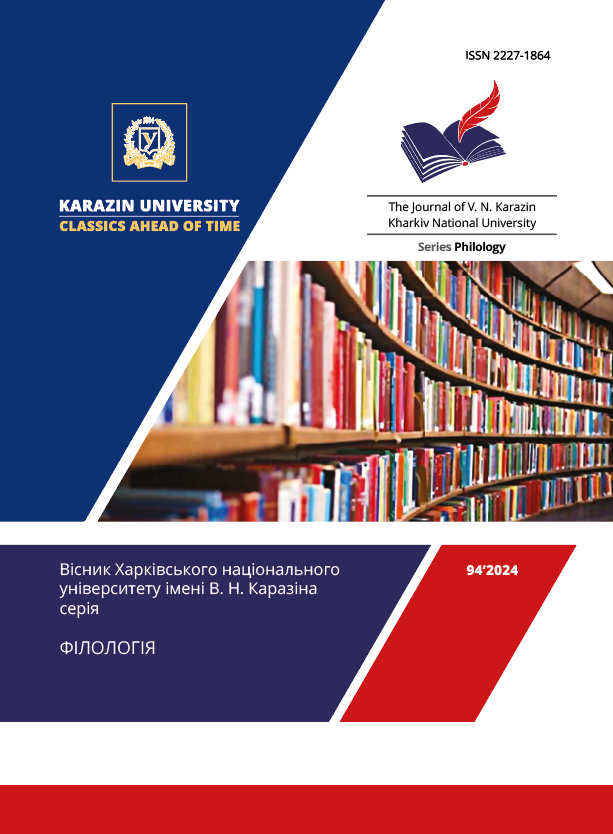Linguistic means of creating an image of a person with intellectual disabilities in D. Keyes’s novel «Flowers for Algernon»
Abstract
Reproducing the speech portrait of a character in the text of a literary work is a difficult artistic task, especially for characters who have certain intellectual impairments and speech disorders, i.e. suffer from aphasia. The writer gives an authentic and detailed description of certain manifestations of aphatic syndromes in the character taking into account both language disorders and psychopathological manifestations that significantly affect the structure and content of the text.
The article defines and characterizes the peculiarities of the use of language means in creating the image of a character with intellectual disabilities in the novel.
The novel under study shows the evolution of the character’s personality: as a result of a scientific experiment (surgical operation), a patient with low level of intellectual development turns practically into a genius. But interfering with the character’s brain gives only a temporary improvement –– rapid progress is replaced by degradation.
The changes in Charlie Gordon’s intellectual development are shown through his speech portrait –– an important means of revealing the image of the character and his inner world. The depiction of the image of a character in a literary work involves giving him speech abilities in accordance with all factors that affect the course of speech, its qualitative and quantitative characteristics (personal, mental, psychological, age, social, national, regional).
The analysis of the novel by D. Keys shows that the writer portrays the character in dynamics, which is also reflected in his speech portrait. Charlie Gordon’s path from a person with intellectual disability to an intellectual genius and vice versa is shown in his reports-records, in which all that happened to him is successively reproduced, and the people he had to communicate with, his worldview and his perception of the world are described.
In order to create the image of a character with intellectual disabilities, D. Keyes chose only a few linguistic means (graphon, capitalization, lexical repetitions) to reproduce the speech of such a person, with a wider range of such means for the image of Charlie the intellectual. The deliberate selection of linguistic means helped to create contrasting images of Charlie as a person with intellectual disabilities and Charlie as a person with a high IQ.
Contrasting speech portraits of the character involves a special expressiveness, addressability and helps D. Keys to create a three-dimensional, multifaceted image.
Downloads
References
Hurbyk, Yu. Yu. (2019). The essence and meaning of the concept of "linguistic characteristic" as a stylistic means of creating character images. Modern movement of science, April 4–5. Dnipro. Pp. 286–290.
Lokaychuk, S. (2019). Language portrait of the Servant from Dobromil based on the novel of the same name by Halyna Pagutyak. Linguistic studies, No. 11. Dec. Pp. 89–99. DOI: https://doi.org/10.29038/2413-0923-2019-11-89-99
Pozdnyakov, D. O. (2019). Speech portrait of a madman in a literary text. Notes on Romano-Germanic philology. No. 2 (43). Pp. 231–237. DOI: https://doi.org/10.18524/2307-4604.2019.2(43).186251
Potebnya, A. A. (1990). Theoretical poetics / Comp., intro. Art., comment. A. B. Muratova. M.: Higher School. 344 p.
Senkiv, O. M., Petrytsia, L. I. (2020). Speech portrait of a hero with special needs (on the example of the works of Daniel Keyes «Flowers for Algernon» and Winston Groom «Forest Gump»). Scientific notes of TNU named after V. I. Vernadskyi. Series: Philology. Social communications. Germanic languages. Volume 31 (70). No. 2. Part 2. Pp. 239–242. DOI: https://doi.org/10.32838/2663-6069/2020.2-2/41
Tsepenyuk, T. O., Vavriv, I. Ya., Dzyubanovska, I. A. V. (2021). Speech portrait of the character of the artistic work in the original and translation. Scientific Bulletin of the International Humanitarian University. Ser.: Philology. No. 49. Volume 2. Pp. 178–182. DOI: https://doi.org/10.32841/2409-1154.2021.49-2.41
Shton, O. (2020). Linguistic features of language portraits in the prose of Vasyl Slapchuk. Studia methodologica. No. 50. Pp. 122–129. DOI: https://doi.org/10.25128/2304-1222.20.50.10
Keyes D. Flowers for Algernon. URL: https://www.sdfo.org/gj/stories/flowersforalgernon.pdf




